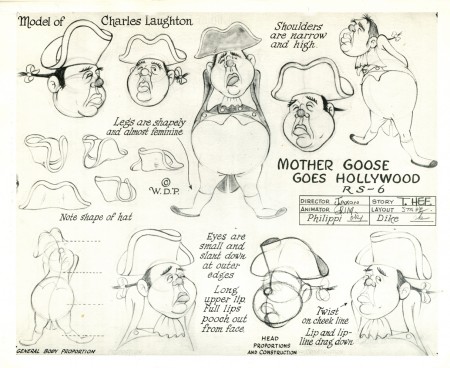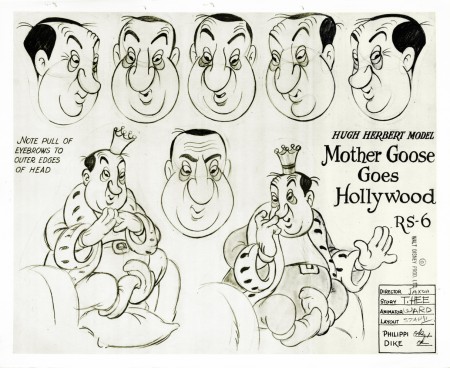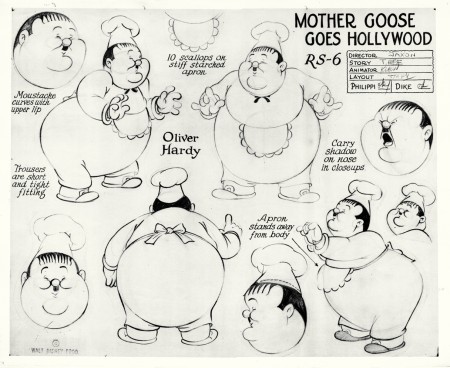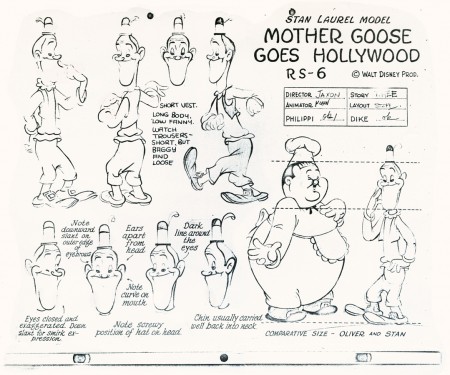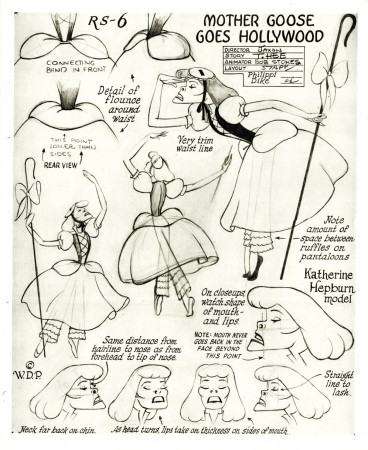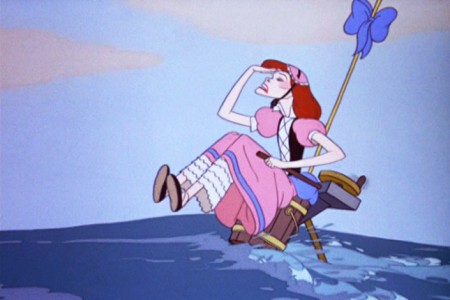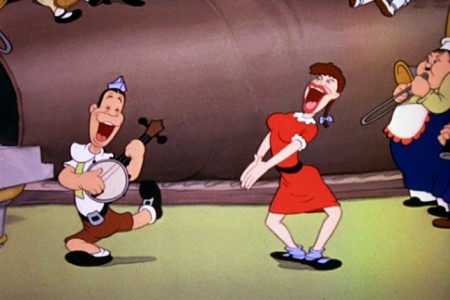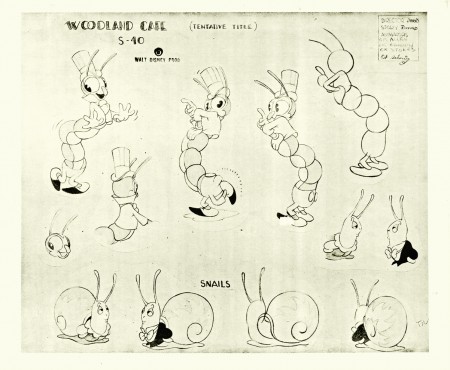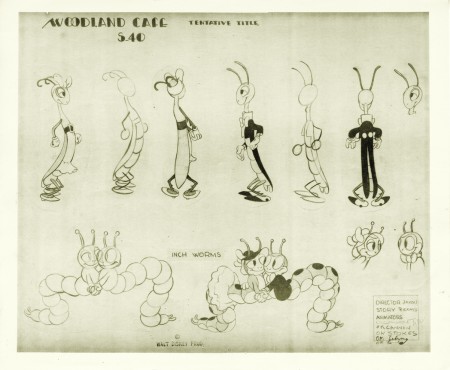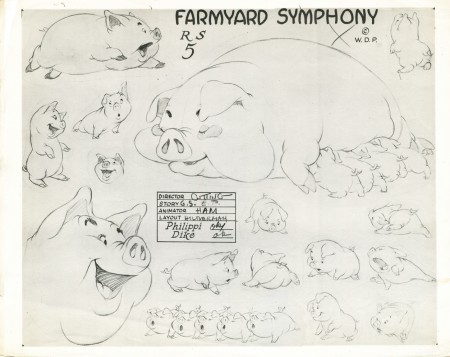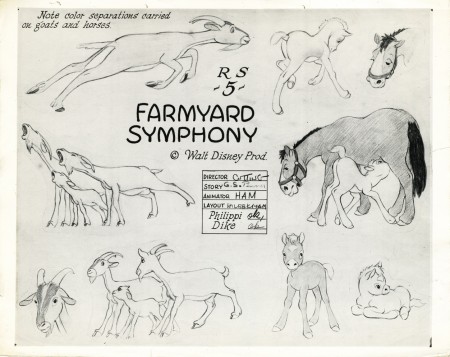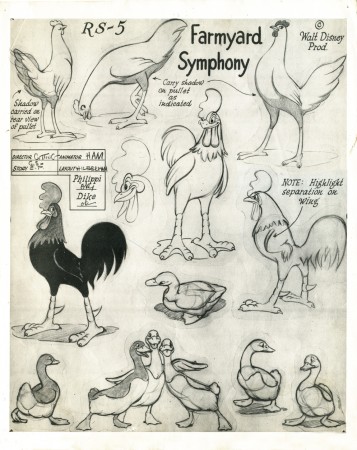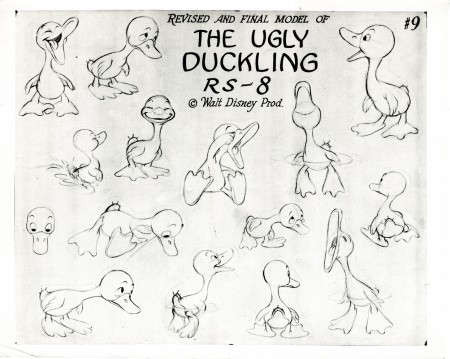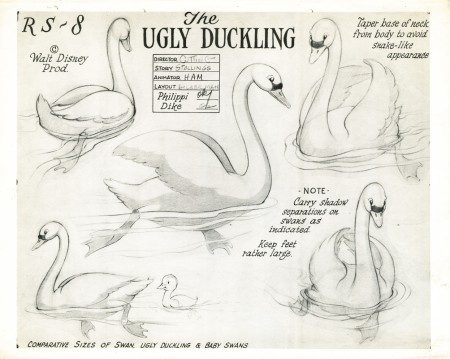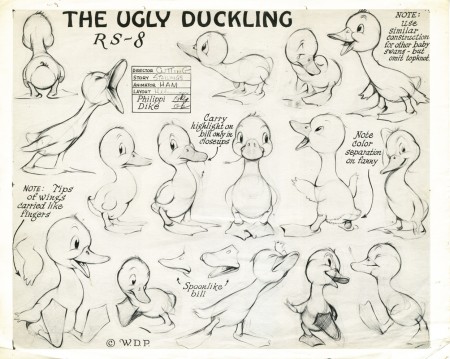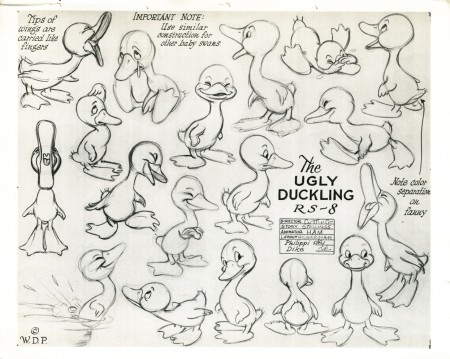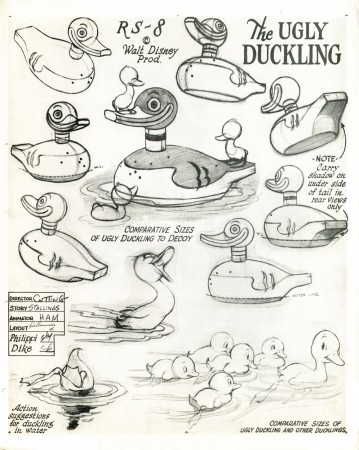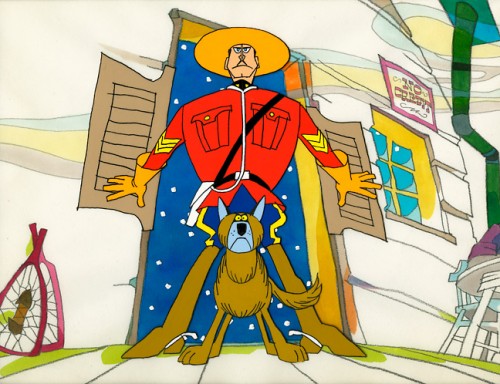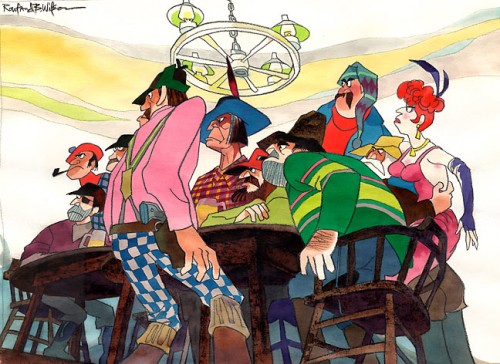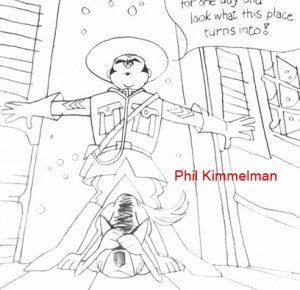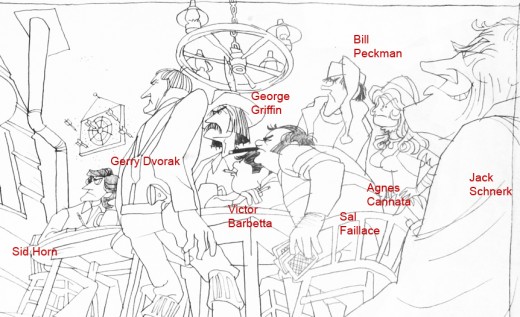Category ArchiveBill Peckmann
Animation Artifacts &Bill Peckmann &Disney &Models &Story & Storyboards 17 Aug 2009 07:38 am
Peter Pan models à la 1940
- Peter Pan was floating around production in 1940. I was reminded of this when I went through the magnificent grab-bag of model sheets that Bill Peckmann has loaned me for this blog. Here are some stunning model sheets which showcase a completely different take on the story before the influence of Mary Blair and the animators
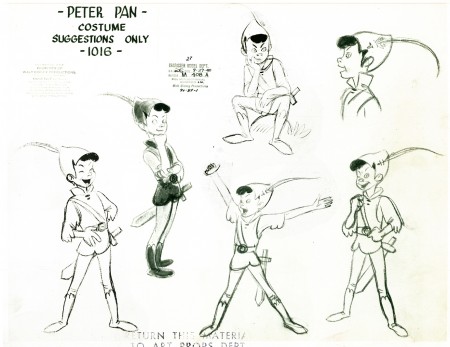
(Click any image to enlarge.)
.
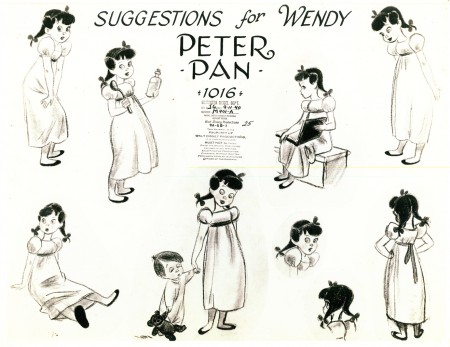
.
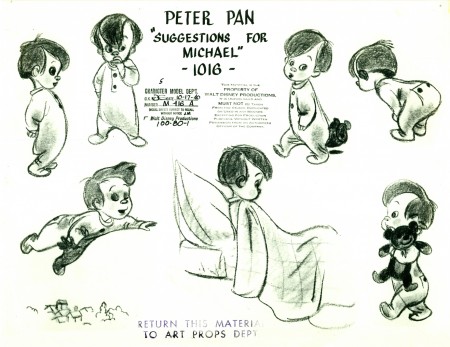
.
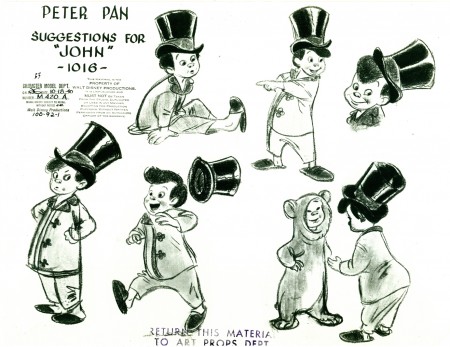
.
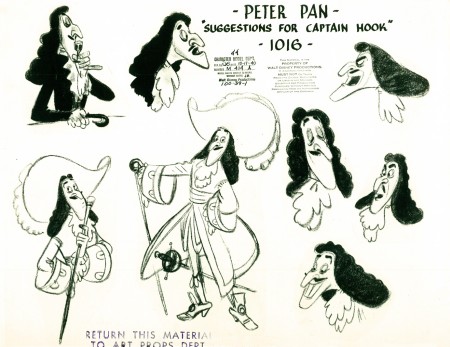
.
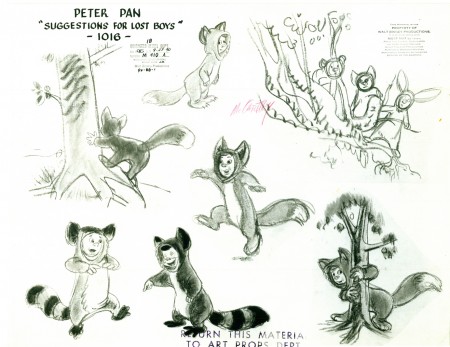
.
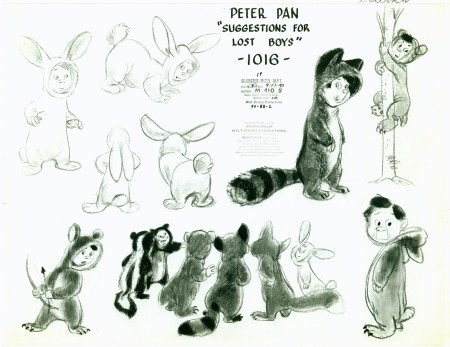
.
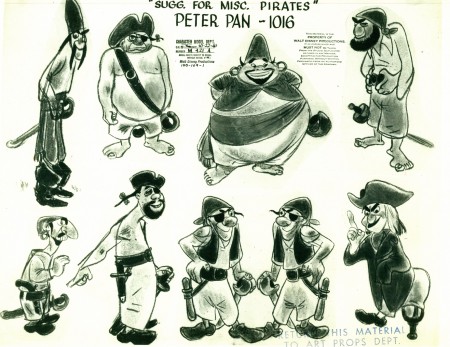
.
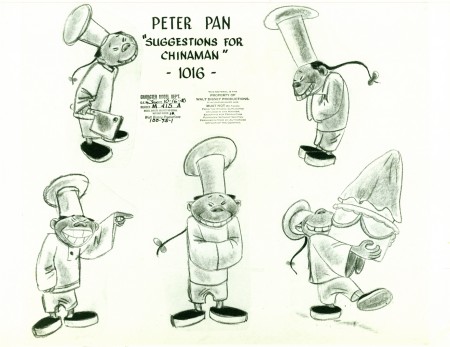
Surprise! A new character which was, fortunately, deleted.
.
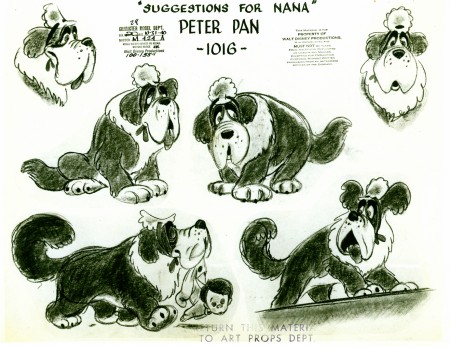
.
Here’s a short bit of 1940 storyboard.
.
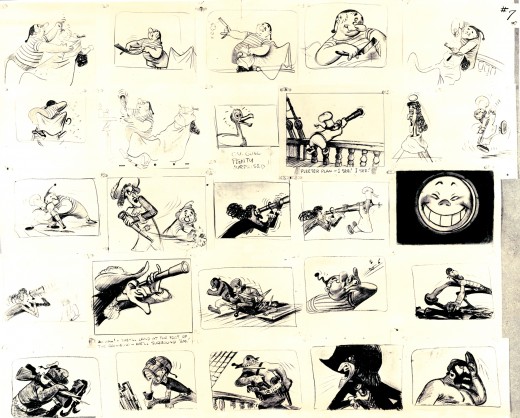
These drawings of Smee are loving and beautiful.
I’d like to know who did them.
And, in case you’ve forgotten, here’s how the final cast looked.
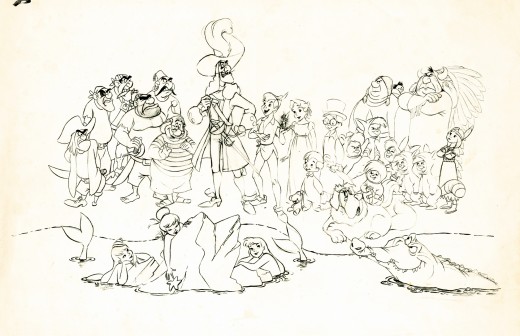
.
Many thanks, again, to Bill Peckmann for the loan of these model sheets.
.
Animation Artifacts &Bill Peckmann &Disney &Models 13 Aug 2009 07:50 am
Mother Goose Models
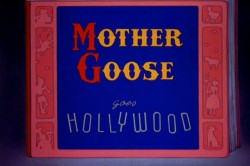 - Here are more of the models from Bill Peckmann‘s collection. I’ve chosen to just focus on the one Silly Symphony, Mother Goose Goes Hollywood. The film showcases the genius of caricature that was possible in animation. (The closest we have today is the flash photo montages of JibJab. No beautiful drawing is involved.)
- Here are more of the models from Bill Peckmann‘s collection. I’ve chosen to just focus on the one Silly Symphony, Mother Goose Goes Hollywood. The film showcases the genius of caricature that was possible in animation. (The closest we have today is the flash photo montages of JibJab. No beautiful drawing is involved.)
Joe Morgan was a major part of the models and design for these characters. The model sheets were signed by director Wilfred Jackson, storyman T. Hee, Animation Director Bob Stokes, and layout director Terrell Stapp. Other anmators include: Izzy Klein, Ward Kimball, Grim Natwick, Jack Campbell, and Don Patterson. Actual credit for story direction went to George Stallings,with T. Hee, Dick RIckard, Leo Ellis, Peeter O’Crotty, Ed Penner, Webb Smith, and Izzy Klein working under him.
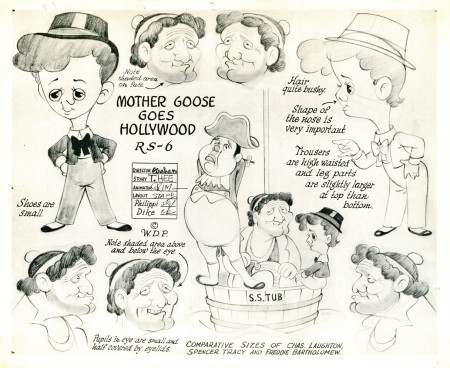
(Click any image to enlarge.)
To give an idea of the color in this film, here are some frame grabs:
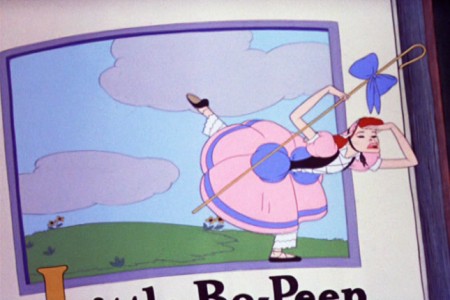
Katherine Hepburn

Hugh Herbert and the Marx Brothers

Hugh Herbert, Donald Duck and Charles Laughton, Spencer Tracy & Freddie Bartholomew

Spencer Tracy & Freddie Bartholomew and Katherine Hepburn

W.C.Fields and Charlie McCarthy

Edward G. Robinson, Greta Garbo and Eddie Cantor

Wallace Beery, Fats Waller and Cab Calloway

Edna Mae Olvier, Mae West, and Zasu Pitts

Edna Mae Olvier, Joan Blondell, & Zasu Pitts and Clark Gable & George Arliss
For other caricature ID’s you can look at the blog, Random Semiconscious Musings.
Animation Artifacts &Bill Peckmann &Disney &Models 10 Aug 2009 07:16 am
A Symphony of Models
- The illustrious NY animation designer/director, Bill Peckmann, is sharing a very large archive of material with this site, so I’ll be posting forever to get it up.
Let’s start with model sheets from some of the Disney Silly Symphonies. You’ve possibly seen some of these, but I like gathering them all in one post.
These are from three gems of films. Among the very best of the shorts.
Woodland Cafe is a beauty released March 1937. these three model sheets are signed by Director Wilfred Jackson, animators Paul Allen, Johnny Cannon, Bob Stokes, Leonard Sebring, and storyman Dick Rickard. Other animators include: Cy Young, Izzy Klein, Dick Lundy, Charles Byrne, Jack Hannah and Ward Kimball. (Story supervision was actually done by Bianca Majolie and I’m not really sure the Sebring animated on this film.) Layout was by Terrell Stapp and John Walbridge.
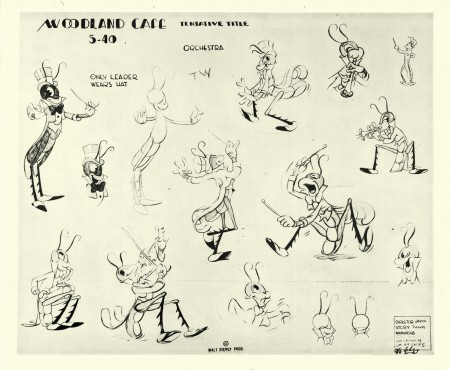
(Click any image to enlarge.)
Farmyard Symphony was directed by Jack Cutting. George Stallings was the story supervisor. Ham Luske signed the sheets for the animators; he was probably the animation director. Animation was done by Eric Larson, Fred madison, John Bradbury, Ken Hultgren, Milt Kahl, Bernard Garbutt, Don Lusk, Paul Satterfield, Lynn Karp, John Sewall, and Paul Busch. Layout was by Dave Hilberman and Art Heinemann.
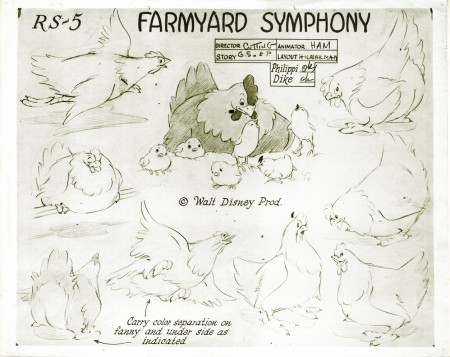
Rel;eased April 1939, The Ugly Duckling won the Oscar and stands out from a lot of the Symphonies of the period. Direction was by Jack Cutting and animation direction went to Ham Luske (which may explain why Luske signed the sheets for Farmyard Symphony as well. Layout was by Dave Hilberman and animation was by Eric Larson, Stan Quakenbush, Riley Thompson, Archie Robin, Milt Kahl and Paul Satterfield. George Stallings was the story director.
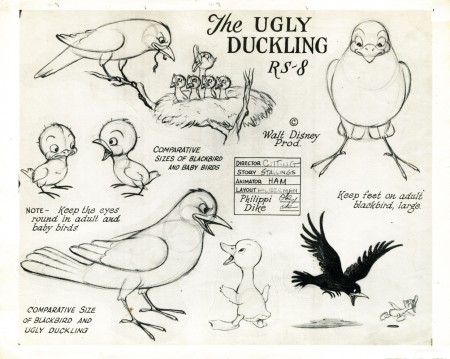
Many thanks to Bill Peckmann. More to come later this week.
.
Bill Peckmann &Daily post &Rowland B. Wilson 20 Dec 2008 09:14 am
Rowland Response
- My piece, posted Dec. 6th, on Rowland Wilson brought a couple of responses via email.
Thanks to George Griffin, I was able to post a caricature of the staff of the commercial studio, Focus, done by Bill Peckman, in the style of Rowland Wilson. To remind you, let me post that drawing again here.
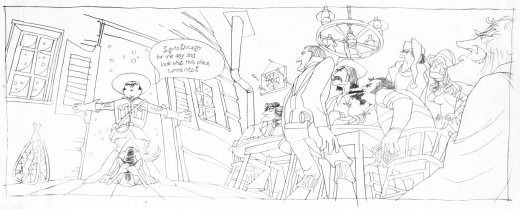
(Click any image to enlarge.)
This prompted Rowland’s wife, Suzanne Wilson to send me this message in a note:
- Enjoyed the Focus on Focus soooooo much!
Thought I would pass along the two Rowland B. Wilson originals that Bill Peckman’s caricature was based on. (Love the “No Credit” sign in the Malamute Saloon!)
It’s great seeing how Bill adapted Rowland’s work, and I thank Suzanne enormously for sharing the artwork.
Then I heard from Borge Ring, who wrote a lengthy comment that was just great to read:
- I knew Rowland Wilson well during the 1970s. We both worked at Dick Will1am’s delightful London studio, often at the same commercials. Rowland was very good company, and his interest in the craft had as many antennas in the air as your blog which is my number one art gallery.
Rowland had fallen in love with animation and joined Dick’s studio to follow Art Babbitt’s lectures. He was intensely busy because next to his work for the studio, he drew well paid advertising cartoons – complicated ones – for a NY ad agency. He always came in early and he worked Sundays but rarely at night. “He said: “That which takes you three hours to get right in the night, you can do in twenty minutes in the morning”
Blake Edwards ordered a 5-minute title for his coming Pink Panther film. It got built “straight ahead” as it were, like at a story conference by a threesome: Dick, Rowland and Ken Harris. So Rowland based upstairs under the roof did a lot of stairs-running in the little old building carrying papers with ever changing concepts. Meanwhile Ken animated the Panther doing a tap dance with straw hat and cane, He confided that: ” If the body movements are right, it does not matter what the feet are doing, as long as they do a lot.” And Dick invented – among other things -how to do Black and White neonsigns for the occasion.
His business partner appreciated the creative euphoria but looked worried because: “Dick is going to spend all the money polishing the animation.”
Rowland designed the famous VODKA commercial, you mentioned, on large celluloids using the broad side of his crayons. He also animated one of the scenes with a locomotive stoker in silhouette throwing a shovelfull of coals into the furnace. His draftsmanship made the short scene look like a piece of live action.
Rowland was helpful to everyone. I once saw him showing a young artist the difference between drawing Disney style figures and “New Yorker style” cartoons. “On the one you whittle away until you get it right. The other one must be there at first stroke, If it isn’t right you don’t whittle. You do a new one”.
“Borg,” he announced, sliding the door to my cubicle. ” The client wants another broooad in thaare” meaning that there would now be four housewives instead of three in the scene. Rowland was a Texan and it was fun to hear this gentle person sound like Hopalong Cassidy.
Rowland cherished the company of Grim Natwick. “He certainly does”, said Dick. “Because he and Grim can talk for hours about …ART. Grim is good, but he is full of bullshit.”
Dick pretended to be allergic to “intellectualism”. He and Art Babbitt shared an office. “Don’t worry … Art is on a culture kick,” he said with a grin. “He has been talking to me for months about a man he calls Moliere; and he hasn’t found out that I don’t know who that is”.
Putting Moliere’s comedies on film was an early dream with UPA when they started.
I think that Rowland’s stint at Dick’s studio was a high point in his career, and his girlfriend Skeesik informed us that, “Life is an acquired taste.”
ps
Rowland and I were having Timsum in Chinatown, and I said: ‘All you guys who draw cartoons in Playboy and the New Yorker. I suspect that your innnermost desire is to draw and paint with light and shadow like they did during the Italian Renaissance. You cannot sell Madonnas and Jesuses, so you opt for illustrating intelligent jokes in elite publications”
He stopped eating and gazed at me.
“Can YOU see THAT?
“Well. a blind chicken finds a grain once in awhile, my dear Watson.” I said trying to hide my own surprise at having scored.
yukyuk
Bill Peckmann &Daily post &Rowland B. Wilson 15 Dec 2008 08:50 am
Focus on Focus
- Here’s a surprise gift from George Griffin. It’s a studio caricature of the commercial studio Focus (this predates even Phil Kimmelman’s own company, PK&A). I’ll let George’s own words inform us about it:
- I came across this copy of a drawing by Bill Peckman you might want to share on your blog. It shows Bill’s adaptation of Rowland Wilson’s design into caricatures of the staff at Focus Design. Wilson had just designed a spot we had all worked on. Phil Kimmelman is the Mountie/authority figure and to the right, Sid Horn, Jerry Dvorak, yours truly, Victor Barbetta, Sal Faillace, Bill, Agnes Cannata and Jack Schnerk. The likenesses are very accurate but the character of each person was inverted: Phil was very sweet and easy-going, Bill and everyone else was very happy, not at all like these scowling toughs.
.
.
.
I’ve split the drawing up and used George’s key to mark up and identify the people within the caricature to make it a bit easier to read.
Michael Barrier has just reviewed both Madagascar 2 and Bolt. His review, as expected, is from a singular perspective though I think he touches on thoughts we’ve probably all had. I look forward, always, to his honest comments.
And speaking of Michael Barrier, Kellie Strøm pointed to a Phil Kimmelman ad on the back page of Funnyworld 20. This was a comment on my Ads for Ad Companies post. Though Kellie links to the ad, I thought it worth post here on its own. It’s a Rowland Wilson illustration.
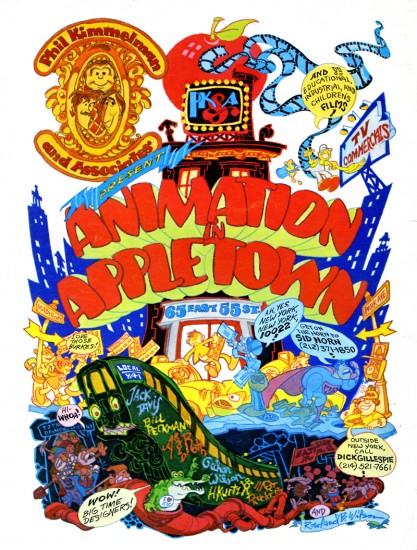 _______________________
_______________________ A blog I’ve just stumbled upon is Ian Lumsden‘s Animation Blog. It’s a British blog with some astute commentary; most of it involving British animated films. The posts on this blog have introduced me to several animators whose work I was unfamiliar with, and whose films I find worth watching out for. The most recent filmmaker under discussion is Ivan Maximov.
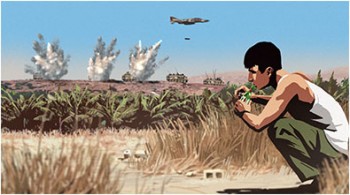 -The NYTimes, yesterday, featured an article about Ari Folman and his feature film, Waltz With Bashir. The film’s about to be released this next week, and this is the start of the relatively small PR run. Here’s hoping this adult film will be noticed by the Academy voters. This is one of two animated films eligible for Oscar nomination in the category of Best Animated Feature that is considered an Israeli film. The other is $9.99 now playin in LA and soon to be released in NY.
-The NYTimes, yesterday, featured an article about Ari Folman and his feature film, Waltz With Bashir. The film’s about to be released this next week, and this is the start of the relatively small PR run. Here’s hoping this adult film will be noticed by the Academy voters. This is one of two animated films eligible for Oscar nomination in the category of Best Animated Feature that is considered an Israeli film. The other is $9.99 now playin in LA and soon to be released in NY.
Animation Artifacts &Articles on Animation &Bill Peckmann 11 Dec 2008 08:33 am
Ads for Ad Companies
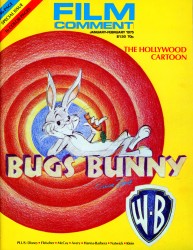 - Flipping through some old film and animation magazines, I couldn’t help but look at all the old ads for the many animation companies that were ever present and are now gone. In a way, back then, you were pleased to see the small companies that promoted themselves regularly in all the film mags.
- Flipping through some old film and animation magazines, I couldn’t help but look at all the old ads for the many animation companies that were ever present and are now gone. In a way, back then, you were pleased to see the small companies that promoted themselves regularly in all the film mags.
You have to remember that animation wasn’t all present back then. It wasn’t easy to find a lot about the medium. Now you just turn on the computer, but back in the ’70s you bought a magazine and cherished the few articles. And when you found something like the Film Comment issue of 1975 (though there were no ads for animation companies in that issue), you kept the magazine close and read and reread the articles. Then you looked at all the ads for the boutique commercial companies.
The following ads all came out of three issues of Millimeter one from 1976 two from 1977.
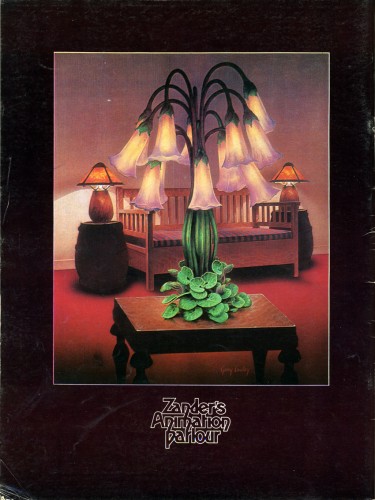
Zander’s Animation Parlour was the largest commercial company
in NY in the 70′s and their ads were the biggest and most entertaining.
They often appeared on the back cover of these magazine issues.
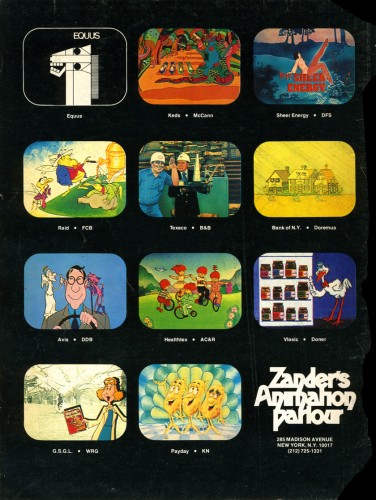
Ads changed from issue to issue, so someone in the studio
kept designing them. Jack Produced the spots with animators
Doug Crane, Dean Yeagle and Bill Railey on staff.
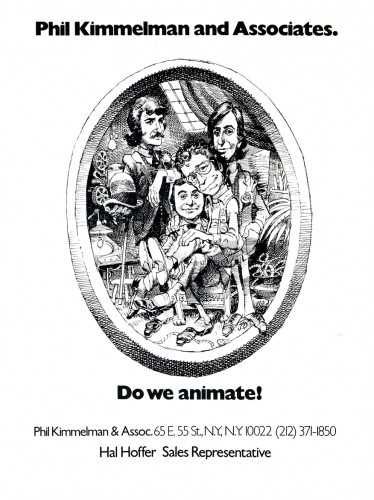
Phil Kimmelman’s studio, PK&A, was also a dominating advertiser.
Though their ads changed, as well, this one appeared often enough
to be recognizable.
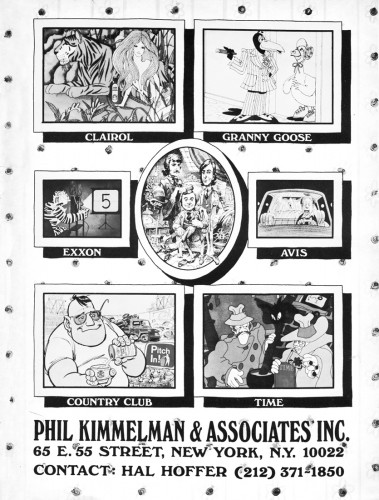
Phil Kimmelman ran the studio with Bill Peckman supervising and
doing layout. Jack Schnerk, Sal Faillace and Dante Barbetta were
regularly used animators.

Perpetual Motion was another large studio run by Buzz Potamkin.
Their ads weren’t as obviously frequent as the other two, but
they did focus on their art.
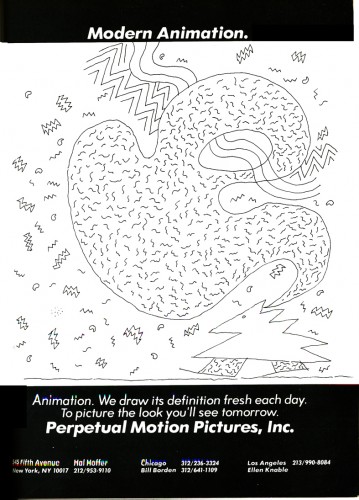
Buzz ran the studio in NY with animators Vinnie Cafarelli and Jan Svochak
on staff. Candy Kugel was the up and coming star to emerge.
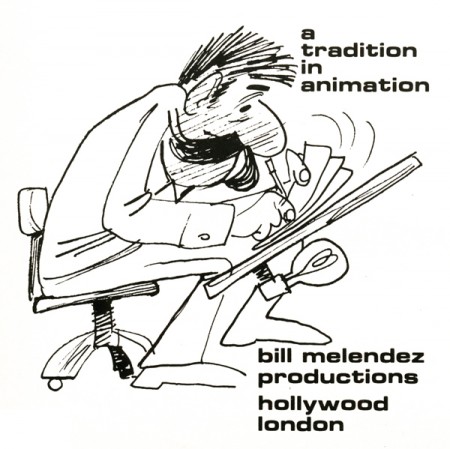
Bill Melendez, on the west coast, did the Charlie Brown shows, but
his studio also did commercials (often featuring Charlie Brown.)
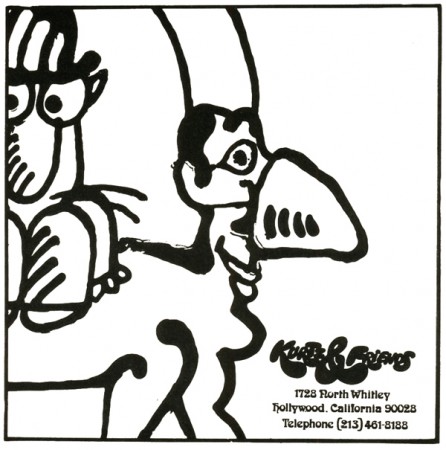
Kurtz and Friends, in California, was hot.
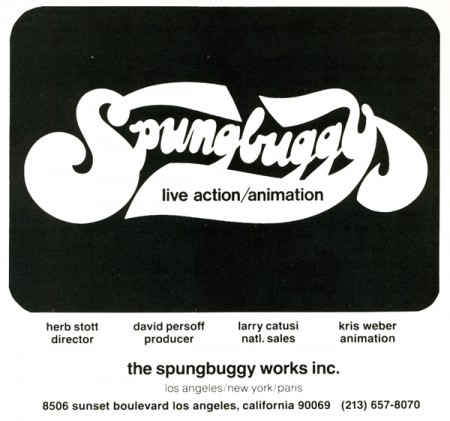
Herb Stott’s Spungbuggy Works certainly caught my eye.
That name for a studio was genius.
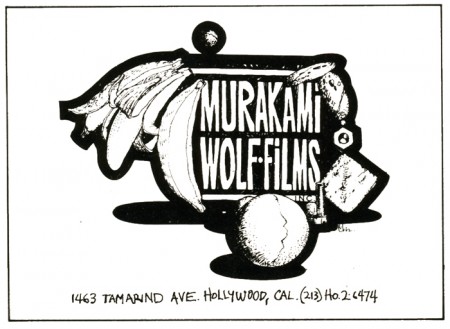
Murakami Wolf, Swensen was a diverse animation studio that seemed to do everything from “The Point” to “Biker Mice From Mars” to commercials.
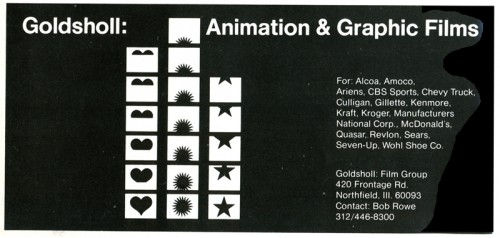
Mort and Millie Goldscholl ran the largest studio in Chicago, Goldscholl Ass.
Their focus seemed to be graphic animation.
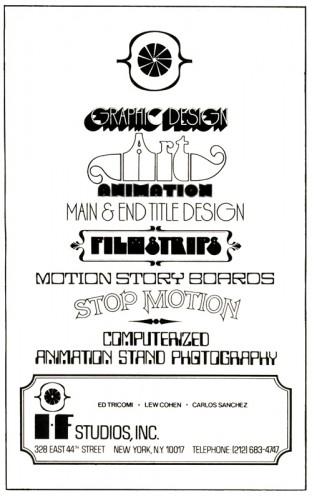
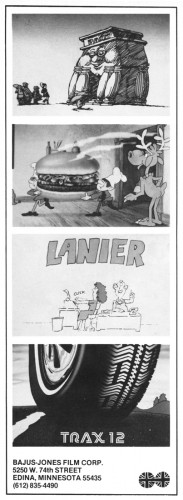
IF Studio was run by cameraman, Carlos Sanchez. They filmed animation
and produced a lot of graphic animation.
Bajus Jones was a hip studio operating out of Minneapolis. They caught a lot of attention and did excellent character animation.
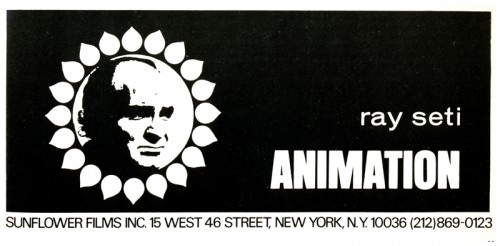
Ray Seti was an animator who opened his own one-man studio. He did a
lot of animatics for commercials and thrived for quite some time.
I have a funny story about meeting him that I’ll hold for another time.
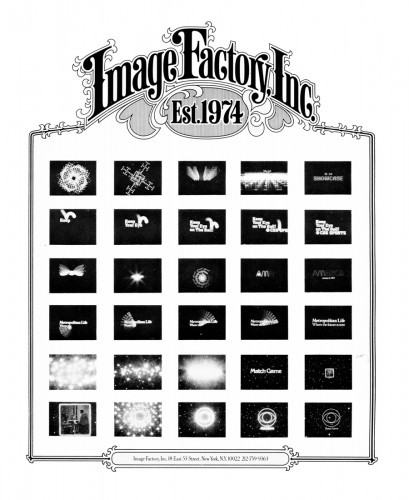
George McGuinnes and Mark Howard ran The Image Factory. They did
dynamic graphic animation. I think I did the only drawn animation for
them – which they used for a graphic spot.
Articles on Animation &Bill Peckmann &Rowland B. Wilson 29 Nov 2008 09:46 am
Producers of 1976
- Last Tuesday I featured the Young Independent animators of 1977. Today let me showcase a couple of commercial producers from the same period. This article came from the famous Raggedy Ann issue of Millimeter/1976, edited by John Canemaker. It was part of their regular column:
PHIL KIMMELMAN
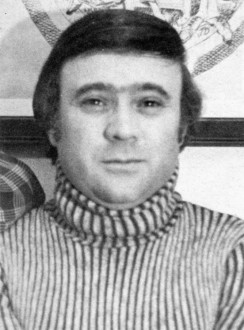 Phil Kimmelman is a New Yorker who stayed. “My love was always animation,” says the cherubic President and Director of Animation at Phil Kimmelman & Associates. At 17, he gave up a three-year scholarship to go to work for Paramount Famous. It was the 50′s; Hollywood was doing fine; budgets were big in the New York animation departments. “I’m delighted to have been a part of that. It really did a lot for me.”
Phil Kimmelman is a New Yorker who stayed. “My love was always animation,” says the cherubic President and Director of Animation at Phil Kimmelman & Associates. At 17, he gave up a three-year scholarship to go to work for Paramount Famous. It was the 50′s; Hollywood was doing fine; budgets were big in the New York animation departments. “I’m delighted to have been a part of that. It really did a lot for me.”
After gaining some experience at Kim-Gifford and Chad Studios in New Jersey, Phil served a stint in the army as an illustrator. In 1961, he joined Elektra as an animator and animation director. “Elektra was into experimenting. We were really into exploring new areas. I think that’s where it all began for me.”
After five years, Phil left Elektra for Focus. Four years later (1971), he opened his own shop. “Fortunately, I wasn’t enough of a businessman at the time to realize how bad things were. We staffed up rather heavily at a time when everybody was resorting to freelance … we got into some problems, but now we’re busier than ever.”
“I consider myself part of a team, the other part being Bill Peckman, one of my associates. We’ve been together through Elektra and Focus. I think Bill’s one of the best talents in this business . . . and I’m glad he’s with me.”
Phil’s other associates are Bill Hegman, designer, and Sid Horn, production manager. Morty Gerstein, a former competitor, is now affiliated as a designer/director. Working madly in the next room is Roland Wilson, a Playboy cartoonist beloved by ad folks for his New England Life campaign.
These gentlemen are just the tip of the iceberg. PK & A is crawling with creative types, and the company has recently leased additional space. “One of the things that has made us successful is the versatility of our reel. We’re great admirers of a lot of cartoonists and designers from outside. If a job comes through that we feel requires a certain look—like a Gahan Wilson or a Jack Davis—we’ll put our own egos aside and go after them. I’ll give you one example: Harvey Kurtzman. Harvey is the creator of Little Annie Fanny for Playboy. He’s best known, I guess, for starting Mad Magazine (he’s no longer with them). We’ve always been fans of Harvey Kurtzman—I think the man’s an absolute genius. Bill Peckman and I chased after him, and he was very apprehensive about working in animation. He said he had a bad experience at one time. But we got him to look at our reel, and at the end of it, he applauded and said he’d be willing to chance it again. So we had Harvey design and write some scripts for Sesame Street, which we’ve sold and produced, and we’ve won a lot of awards with them. They’re beautiful spots—and they’re one example of the ‘Kimmelman look.’ ”
Yes, but how does he work with agency art directors and writers? “When an agency board comes in, I like the option of taking the board and recreating it to our way of thinking. Generally, that’s why they come to us—for our input. I think a lot of art directors and writers are not really geared, you know, to think animation. When he or she gets involved in animation, there’s a long time period where there’s very little to do. You know, it’s difficult for the people in agencies who are making the schedules to understand the time element. Where we used to have a good eight weeks to do an average 30-second commercial, we’re constantly being asked to do it in four or five weeks. It’s what I see happening more and more today that kind of upsets me. We’re working nights—around the clock—too often. That’s what it’s become. I guess we love it enough to keep doing it. I do have a line I won’t go over. If I really feel it can’t be done, we won’t do it. I’ve been in that situation many times.”
What about Ralph Bakshi and his controversial coonskins? “Fantastic. Whether you or I like his films, there’s no question that they’re breakthroughs. He’s gotten animation into the adult mind. For that reason alone, I’m delighted it’s happening.
“I think it’s sad. So much more should be happening in this industry. I think animation still hasn’t been scratched. It’s an extension beyond what live can do. There’s no limit. There are people who think it’s a dying art. I don’t think it will ever die. I’m very optimistic about that. I think, if anything, it can only go upward.”
JERRY LIEBERMAN
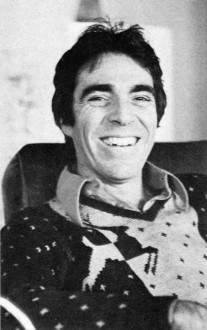 Jerry Lieberman says he originally “wanted to be a doctor,” and he endured two years of pre-med before allowing all the “fantasy, other-world head aspects involved in growing up in corny, carny, show-biz pizzaz-zy Atlantic City” to take over. As a kid he “always drew” and worked three summers as a caricaturist on Atlantic City’s Million Dollar Pier.
Jerry Lieberman says he originally “wanted to be a doctor,” and he endured two years of pre-med before allowing all the “fantasy, other-world head aspects involved in growing up in corny, carny, show-biz pizzaz-zy Atlantic City” to take over. As a kid he “always drew” and worked three summers as a caricaturist on Atlantic City’s Million Dollar Pier.
He admired John Hubley’s Moonbird (1960) and Saul Bass’ titles and he constructed his own make-shift 16mm camera stand to “experiment with stop-motion, and even some professional work for WCAU-TV in Philadelphia doing promos for a local kids’ show.”
After studying design and graphics on a scholarship to the Philadelphia Museum’s School of Art, and a brief stint in the Army, Jerry came to New York City in 1964. “My first year in New York,” says Jerry today, “I made a storyboard six feet by ten feet long with 200 panels. It was my portfolio and it used to knock people over when I unfolded it.”
He managed to get work right away doing animated films for NBC-TV’s Exploring, “but I learned success doesn’t come easy. There were times when I walked the pavements going from one local production house to another for six months before getting work. One time my portfolio was so severely criticized by one potential employer, I stopped seeing people and had a phobia about work and my talent.
“I worked very hard; I paid my dues; eventually I made a lot of money in a short time and went to Europe. I thought foreign influences might be good for my work.” In London, Jerry met George Dunning who told him “the best place to go for work is Italy.” In Rome, Jerry was hired by American Harry Hess, a former UFA animator, and he worked for a year doing storyboards, design and animation for Italian commercials both in Rome and Milan. He even acted in a few live-action beer commercials.
Jerry returned to America with an excellent reel and his next big break was to be hired by Jack Zander at Pelican Productions as a designer. “Because animation does include every form of art, I wrote to Lee Strasberg and asked to join the Actor’s Studio Directors Unit, and I was accepted and studied there for two years. After a year at Pelican, he freelanced on educational films and was, for a short hilarious time, Phyllis Diller’s painting instructor.
“In 1968, Art Petricone, Howard Basis and I got together and started Ovation Films, Inc.,” says Jerry. “Howard and Art met at Kim and Gifford, and I had worked with Howard on a job. We started our business during the decline of the ‘Golden Years’ of TV commercial production, but we didn’t know that at the time. We had our reputations, things built up slowly, and in March of ’76 we’ll have been in business for eight years.”
Ovation is one of the top commercial houses on the East Coast, a successful studio whose award-lined walls attest to their excellent work done for clients who include Eastern Airlines, Volkswagen, Levis, American Cancer Society, Clairol, and Children’s Television Workshop. At first, duties at Ovation were sharply defined, with Jerry doing designing, Howard handling the animation, and Art the super salesmanship, but today Jerry explains that “each of us get involved in producing and directing different commercials. Sometimes we work separately, sometimes we work together. We are now doing a little live-action work, and we are interested in doing a feature animated cartoon. Creativity, budgets keep getting tightened up, but we manage to maintain quality in our product.”
In 1973, Jerry enjoyed “a great personal success,” as La Cinematheque Quebe-coise directrice Louise Beaudet describes it, at the Annecy Animation Film Festival. “His films were so American and he looked so American when he took a bow that he was a big hit with the French,” says Madame Beaudet. Ovation’s Yes My Sweet took a prize at Annecy that year, as their Parrot and the Plumber had at Zagreb the year before.
“I admire live-action directors who are interested in the visual aspects of film,” says Jerry as he ticks off the names of favorites Warhol, Fellini, Russell, and Hitchcock. “But I love animation because you have to be so multi-talented and involved in so many fields. It’s very demanding, always a challenge, and very satisfying.”
- For a short period in 1973, I worked for Phil Kimmelman’s studio PK&A. I was an Asst. Animator alongside Larry Riley. We had a brilliant time for a period, until work got a bit shy. The studio was very tight, and the mood was one of searching for the highest quality. Rowland Wilson was a designer of many of the Schoolhouse Rock pieces I assisted on. Phil was a pleasant guy to have for a boss, and I certainly enjoyed the experience.
He retired a few years back, but he’s back producing more Schoolhouse Rock episodes for Disney. I’m glad to see it.
Jerry Lieberman was someone I came into contact with frequently. We never worked together. Somehow I think he always saw me as a rival – I don’t know if that’s a reality, but it’s my perception. The last couple of times I met him he was directing theater and loving it.
